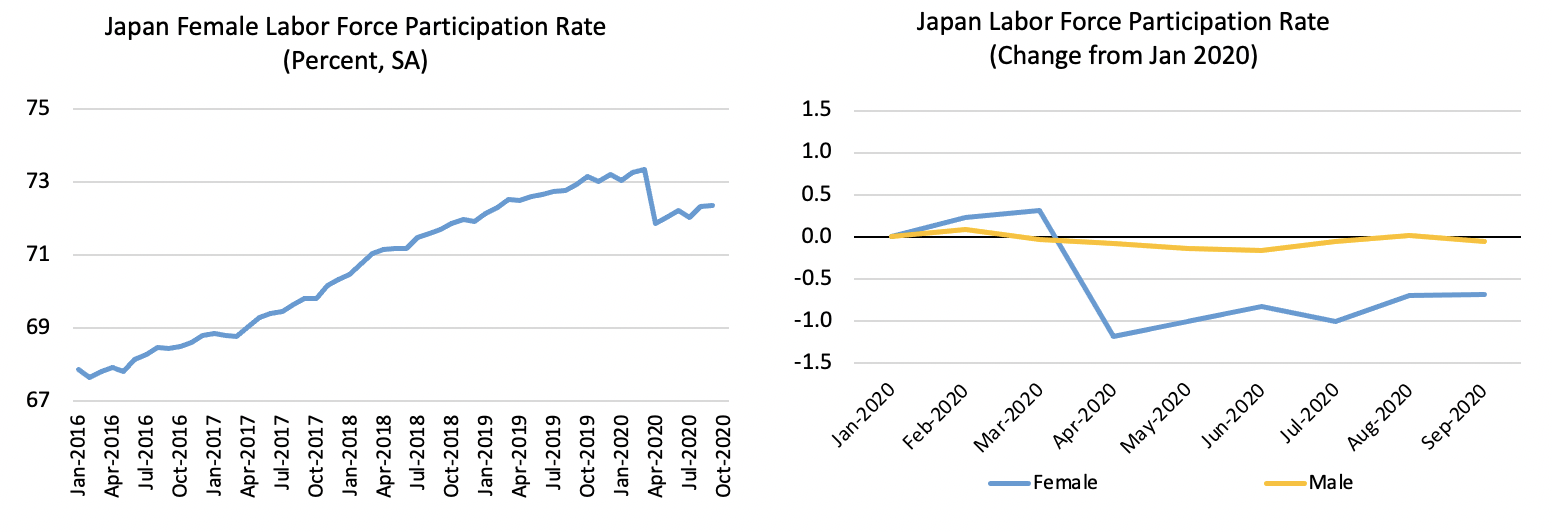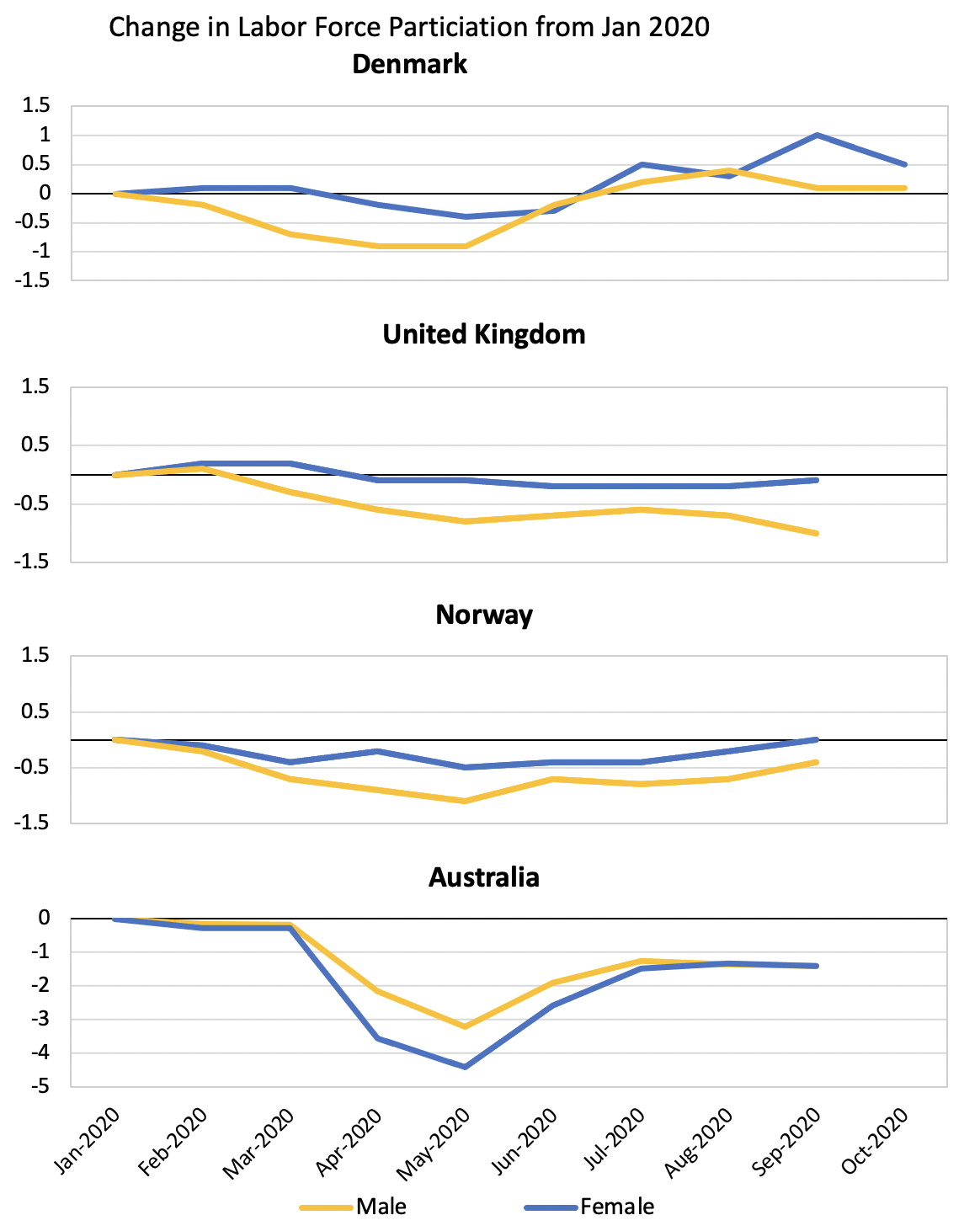New research has presented evidence that the gender gap in labour force participation in US has expanded during COVID-19 (Alon et al. 2020). This negative development is attributed to two factors – the disproportionate impact that the pandemic has had on sectors that tend to employ more women, and the increase in family caregiving responsibilities due to kindergarten and school closures that lay on working mothers’ shoulders. Both reasons keep women away from the labour force (Landivar et al. 2020).
The US is hardly the average labour market, however, both due to its size and its flexible employment regulation. We hence expand the analysis to several other advanced economies that have readily available data, by looking for trends in the labour force participation by women. We find that women’s labour force participation has declined during COVID-19 in Canada, Japan, South Korea, and the US, while it has been resilient to the crisis in (see Figure 1). In particular, the gender gap in August/September is around 0.8% higher in the former four economies mentioned than that in January 2020. In contrast, the gender gap has closed by 0.5% in the latter four advanced economies.
Figure 1 Gender gap in labour force participation rate
a) Countries with an expanding gender gap
b) Countries with a shrinking gender gap
Source: Authors’ calculation. Seasonally adjusted monthly labour force participation rate (age 15-64) for US, Japan, Canada, South Korea, and Australia are from OECD. Seasonally adjusted series for UK (age 16-64; three-month moving average), Denmark (age 15-74; three-month moving average), and Norway (age 15-74; three-month moving average) are from national sources.
Japan is an example of an economy where women in the labour force have suffered disproportionate job losses during COVID-19. Labour force participation by women grew from 68% in 2016 to 73% in 2019, a significant progress (Hyland et al. 2020). Yet, COVID-19 reversed this progress and took away one million Japanese women from the labour market earlier this year, while labour force participation by men barely budged (Figure 2). This is despite the introduction of a crisis response policy that offered to partially compensate paid leave provided to employees unable to work due to the closure of their child’s care or education facility.
Figure 2 The expanding gender gap in Japan
Source: OECD.
Unlike Japan, both female and male labour force participation declined initially in Canada and South Korea. However, Canada’s labour force participation for men had already reached a level higher than before the pandemic by October 2020, while that for women has not recovered.
In Denmark, Norway, and the UK the labour force participation for men has declined more than that for women, thus narrowing the gender gap (Figure 3). In contrast, women’s labour force participation in Australia has rebounded stronger than that for men, with the rate in September being 3% higher than at the lowest point in 2020 for women, but only 1.8% higher for men.
Figure 3 Gender gaps are decreasing in Australia, Demark, Norway, and the UK
Source: OECD, UK Office for National Statistics, Statistics Denmark, Statistics Norway.
There are two main hypotheses about the factors that contribute to these different trends during the pandemic. The first is the sectoral composition of the economy and the nature of women’s participation by industry. In all economies, women are overrepresented in many COVID-affected industries, including retail trade, food and accommodation services, the arts and recreation fields, and social assistance.
One crisis policy measure is the temporary reduction of the VAT rate for crisis-affected businesses, as done for the tourism and hospitality sectors in the UK (Hupkau and Petrongolo 2020). Second, UK businesses in the retail, hospitality, and leisure sectors are entitled to a one-off cash grant of up to £25,000 from their local council. A third measure that has been credited with reducing the gender gap in the UK during COVID-19 is that eligible childcare centres are exempted from council property tax from 2020 to 2021 (Galasso et al. 2020). Fourth, parents who have reduced work hours in the pandemic are eligible to offset childcare costs through tax credits.
In Norway, the VAT rate was cut down from 12% to 6% for passenger transport, accommodation, and entertainment. The Norwegian government also provides grant support to businesses in the retail trade, hospitality, and entertainment sectors. In Denmark, where the part-time employment rate for women is 55% as compared to 35% for men, the government’s wage support scheme that covers up to 90% of part-time wages is getting credit for the resilience of labour force participation by women.
The second reason is the disproportionately high burden of work at home that falls on women during the pandemic. In Canada, employment among women with toddlers or school-aged children fell 7% between February and May 2020, compared with a 4% decrease for fathers of children the same age. Employment for single mothers with a toddler or school-aged child dropped 12% between February and June, compared with 7% decrease for single fathers (RBC 2020). In the UK, women on average do 60% more unpaid homecare work than men, and this proportion has gone up during the lockdowns (Ogletree Deakins 2020). The disproportion is even greater in Japan – women spent almost six times more than men on childcare and housework (Statista 2020).
One reason for the quick recovery in female labour force participation in Australia is the childcare subsidy, introduced as a crisis response measure. The Australian government provided free childcare to around one million families from April 6 to July 12 (the programme’s cancellation thereafter has been subject to criticism) and extended financial support to childcare facilities. In a similar measure, the paid days for taking care of small children (e.g. due to closed schools or daycares) in Norway have been doubled from 10 days to 20 days. South Korea has introduced an emergency family care subsidy for employees taking leave to attend to their children during COVID school and daycare closures for up to 10 days.
Lessons from the success of early crisis response measures to reduce the gender gap in labour force participation can serve to inform future COVID-19 recovery programmes. Previous research suggests that it takes significant time to reintegrate women in the labour force once out of work (Goldin 2015). This research should be taken to heart with policies that ensure job retention during the crisis.
References
Alon, T, M Doepke, J Olmstead-Rumsey, and M Tertilt (2020), “The Impact of COVID-19 on Gender Equality”, Covid Economics 4.
Galasso, V, V Pons and P Profeta (2020), “Gender differences in COVID-19 perception and compliance”, VoxEU.org, 7 November.
Goldin, C (2015), “How to Achieve Gender Equality”, Milken Institute Review, Q3: 24-33.
Hupkau, C, and B Petrongolo (2020), “COVID-19 and gender gaps: Latest evidence and lessons from the UK”, VoxEU.org, 22 April.
Hyland, M, S Djankov, and P Goldberg (2020), “Gendered Laws and Women in the Workforce”, American Economic Review: Insights 2(4): 475-90.
Landivar, L, L Ruppanner, W Scarborough, and C Collins (2020), “Early signs indicate that COVID-19 is exacerbating gender inequality in the labor force”, Socius 6: 1-3.
Ogletree Deakins (2020), “The Impact of COVID-19 on Gender Pay Equality in the UK Workplace”, 15 June.
RBC (2020), “COVID Takes Drastic Toll on Women's Participation in Labour Force”, 21 July.
Statista (2020), “Time spent on housework among married couples in Japan in 2016, by gender”, 13 October.










